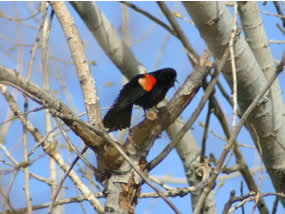 |
 | |
  | |
|
|
|
|
Whitman Mission National Historic Site
Birds
|
|
|
|
|
|
 |
 |
| NPS collection | | Male red-winged blackbird singing in tree. |
 |
Whitman Mission supports a surprisingly rich diversity of bird life. A large proportion of the species are migratory and wintering birds, indicating the importance of the 98-acre parcel as a stop over for those species. The Mill Pond is used by many species of waterfowl and the riparian and grassland vegetation attract a wide variety of passerines. Of particular note are the many insectivorous flycatchers, vireos, and warblers that use the historic site as a migratory stop over and as a nesting area. Another important resource for birds is the dead and dying cottonwood trees found along Mill Creek and the Walla Walla River. These snags provide important resources for primary cavity nesters, such as the northern flicker and provides even more critical habitat to secondary cavity nesters such as the western screech owl. Rookeries of black-crowned night herons and great blue herons exist along Mill Creek near the west boundary of the historic site.
The 2002-2003 Vertebrate Survey confirmed the presence, at least occasionally, of 202 species of birds in or near the park. These have been placed onto lists based on residency status and abundance. For definitions of the various residency categories or abundance categories see .
List of Birds that Breed at Whitman Mission NHS
List of Non-breeding, "Resident" Birds
List of the More Common Migrants
List of Less Common Migrants
List of Unexpecteds, Vagrants, and Residency Status Unknown
Material excerpted from: 2002-2003 Vertebrate Inventory: Whitman Mission National Historic Site. University of Idaho and National Park Service Columbia Cascades Support Office.
|
|

|
 |
|
|
|
|
|
 |
|
Did You Know?
In November of 1969 American Indians being relocated and terminated by the U.S. government occupied the then vacant island of Alcatraz. Their 18 month occupation would bring an end to the federal termination policy, saving the tribes.
|
|
|
|
Last Updated: February 13, 2007 at 18:57 EST |






